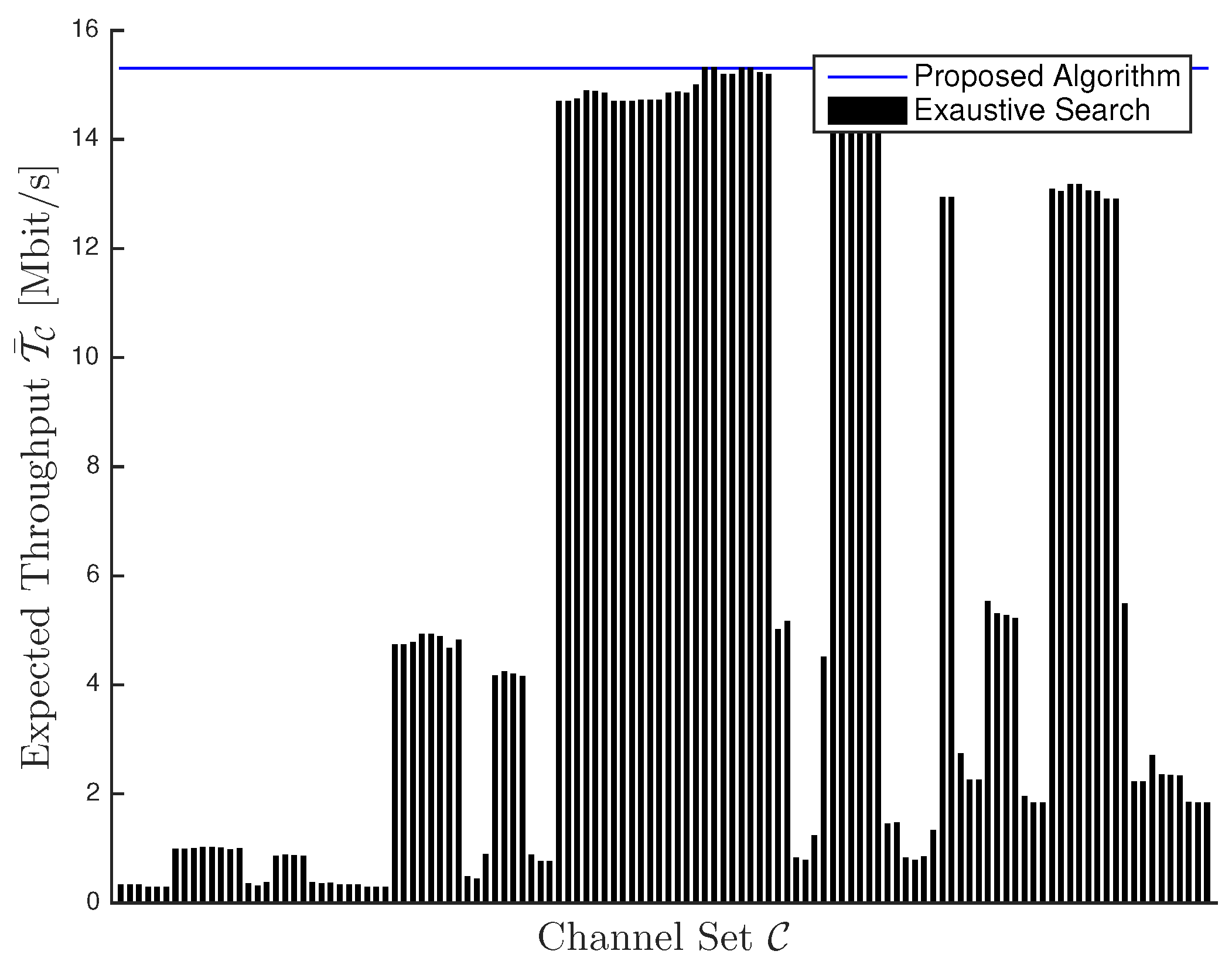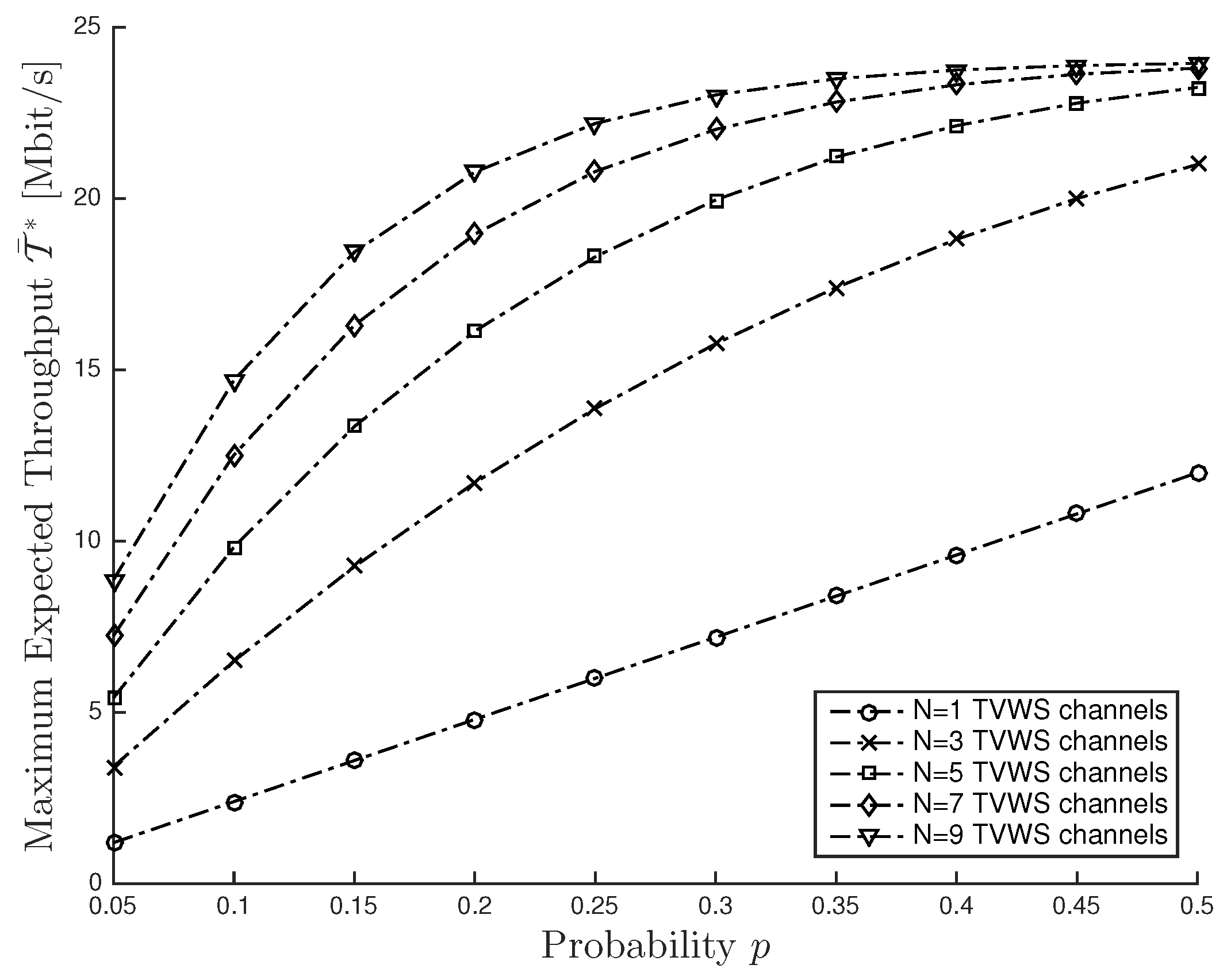1. Introduction
In recent years, regulatory bodies such as FCC and Ofcom [
1,
2,
3] have approved the dynamic access of unlicensed sensor networks, referred to in the following as Secondary Sensor Networks (SSNs), to the TV White Space (TVWS) spectrum. The existing regulations circumvented the need for sensing algorithms for establishing the availability of free TVWS spectrum [
4,
5,
6,
7], since they require the SSNs to periodically obtain the the list of TVWS channels free from licensed users from a geolocated database [
8,
9]. Hence, it is reasonable to expect that multiple and heterogeneous SSNs based on different standards such as [
10,
11,
12] are expected to coexist within the same geographical region over shared TVWS spectrum. Stemming from this, in this paper we develop an analytical framework for modeling the throughput achievable by an arbitrary SSN operating over shared TVWS spectrum in presence of coexistence interference. Specifically, we first analytically derive the expected throughput as a function of the channel ordering. Then, the problem of deriving the maximum expected throughput through exhaustive search is shown to be computationally unfeasible. Furthermore, a computational-efficient algorithm for ordering the channels to maximize the expected throughput is designed and, stemming from this, a closed-form expression of the maximum expected throughput is derived. Finally, numerical results validate the theoretical analysis.
2. System Model
We consider a SSN communicating through the TVWS spectrum in agreement with the existing standards and regulations. Hence, with an access to the TVWS database, the SSN obtains the list of channels free from licensed users. In the following, we denote with
the set of free channels, and with
the expected throughput for the
i-th channel. For the reasons described in the introduction, any incumbent-free channel in
may be affected by coexisting interference caused by other heterogenous SSNs operating over the same TVWS channel within the same geographical area. In the following,
denotes the probability of the
i-th channel being not affected by coexistence interference (the SSN can estimate the interference probability through the past interference history [
8]), with
. Furthermore,
denotes an arbitrary channel set,
i.e., an ordered sequence of available channels without repetition:
The order among the channels reflects the priorities for channel utilization, i.e., channel is used if and only if: (i) all the channels with higher priority are affected by coexistence interference; (ii) channel is not affected by coexistence interference. In the following, we denote with the optimal channel set, i.e., the channel set that maximizes the expected throughput.
3. Expected Throughput
In this section, we first derive the closed-form expression of the expected throughput as a function of the adopted channel set, say
. To this aim, some preliminaries are needed. We denote with
the probability that the first
channels
with higher priority with respect to
are affected by coexistence interference. By exploiting the reasonable hypothesis of independent SSN activities over different channels, it results that
is given by:
Hence, the expected achievable throughput
is equal to:
with
denoting the probability of channel
being not affected by coexistence interference and
denoting channel
expected throughput, respectively. From Equation (
3), it results that
depends on the adopted channel set. In the following, by deriving the optimal channel set
, we are able to compute the maximum expected throughput
achievable by an arbitrary SSN operating over shared TVWS spectrum:
We first observe that the computation of the maximum throughput through exhaustive search is computationally unfeasible. In fact, the number of channel sets is equal to the number of permutations of distinct objects. Consequently, computing via exhaustive search is as much computational hard as solving the NP-hard traveling salesman problem via brute-force search. Nevertheless, in the following, we derive a rule for ordering the channels to maximize the expected throughput and, stemming from this result, we design a computational feasible algorithm for computing .
4. Maximum Expected Throughput
Let us suppose that
. We prove that channel
must have higher priority than channel
with a
reductio ad absurdum by supposing that there exist a channel set
different by channel set
defined as:
so that:
By accounting for Equation (
2), we have
As a consequence, by using Equations (
5) and (
6), it results:
By accounting for Equations (
7) and (9), we have
for any
. Hence, Equation (
6) is equivalent to:
By substituting Equations (
2) and (
8) in Equation (
10), and by using again Equations (
5) and (
7), with some algebraic manipulations, it results:
Equation (
11) constitutes an absurdum since for hypothesis
.
By exploiting this result, it follows that to obtain the optimal channel set
,
i.e., the channel set that maximizes the expected throughput, the channels must be sorted according to their expected throughput,
i.e.,
Equation (
12) constitutes also a computational-efficient algorithm for evaluating the maximum expected throughput
. In fact, its time complexity is bounded by
due to the sort operation. From Equations (
3) and (
12), we finally obtain the expression of the maximum expected throughput
:
5. Numerical Results
In this section, we adopt, as case study, a sensor network operating in the TVWS spectrum according to the IEEE 802.11af standard. This standard, also referred to as White-Fi, allows wireless local area network operation in TV white space spectrum in the VHF and UHF bands between 54 and 790 MHz.
First, we validate Equation (
12) by showing that the expected throughput derived in Equation (
13) constitutes the maximum expected throughput. The set of parameters is as follows. The TVWS spectrum is organized in
channels, and the corresponding interference probabilities are uniformly distributed in
. By adopting a 6MHz bandwidth for the IEEE 802.11af standard, the set of achievable data rates is
Mbit/s, and the channel throughputs are uniformly distributed within the set.
Figure 1 shows the expected throughput
for each of the
sets
. Furthermore, we report the expected throughput derived in Equation (
13). First, we note that expected throughput derived in Equation (
13) effectively constitutes the maximum expected throughput. Hence, Equation (
12) provides the sorting rule maximizing the expected throughput. Furthermore, we note that there exists a significant variability in terms of expected throughput among the different channel sets, ranging from less than 1 Mbit/s to over 15 Mbit/s. This result highlights the importance of studying the throughput achievable by an unlicensed sensor network operating over TV white space spectrum in presence of coexistence interference.
To better characterize the effects of the parameters on the expected throughput, in
Figure 2 we show the maximum expected throughput
as a function of the channel availability probability for different values of the number
N of TVWS channels,
i.e.,
. The simulation set is as follows:
and
Mbps for any
. We can observe that the maximum average throughput is significantly affected not only by the probability
p, but also by
N. Specifically, we observe that, for the lower values of
p, there exists a difference in terms of
for different values of
N. In contrast, for the larger values of
p, the difference in terms of
for different values of
N decreases as
N increases. Furthermore, we observe that the maximum expected throughput increases as
N increases. This effect is reasonable, since
N controls the degrees of freedom in terms of channel opportunities.
The conducted analysis has proved that the throughput available at an arbitrary secondary sensor network operating over shared TVWS space in presence of coexistence interference depends on the channel set. Furthermore, it has shown that there exists a computational-efficient algorithm for determining the channel set maximizing the throughput. Hence, in a nutshell, secondary sensor networks can maximize the throughput by scanning the channels in decreasing order of expected throughput and by utilizing the first channel not affected by coexistence interference.







